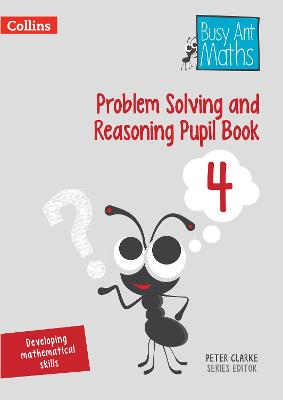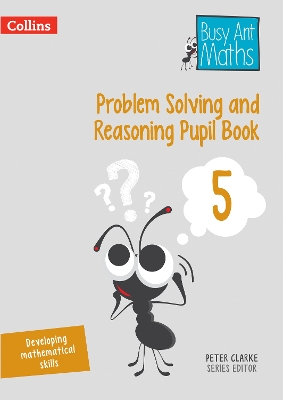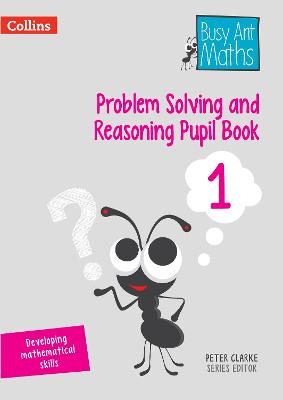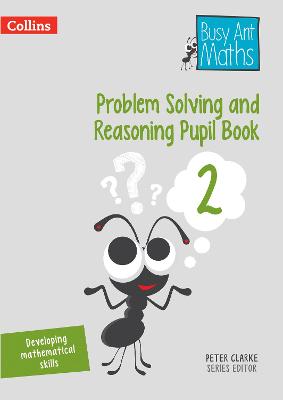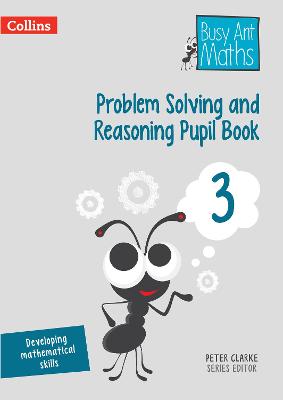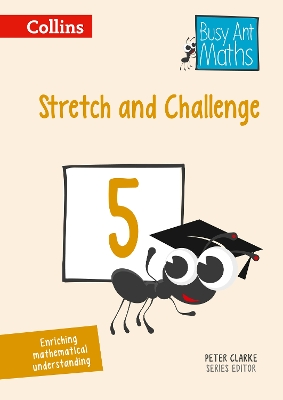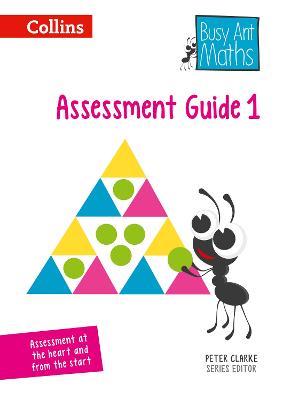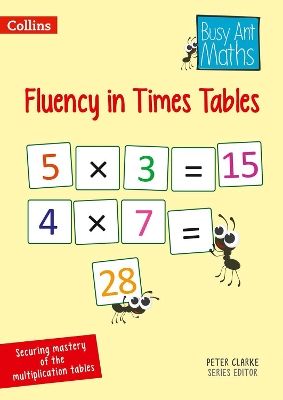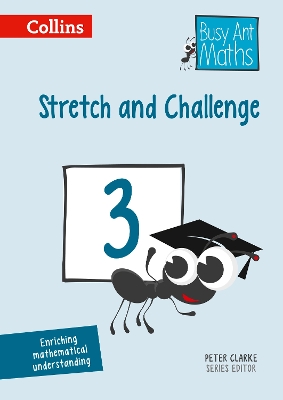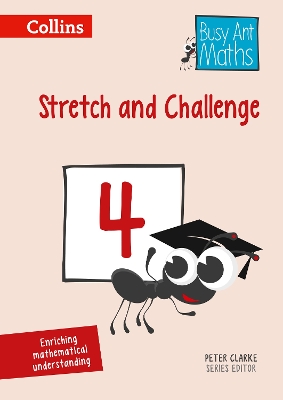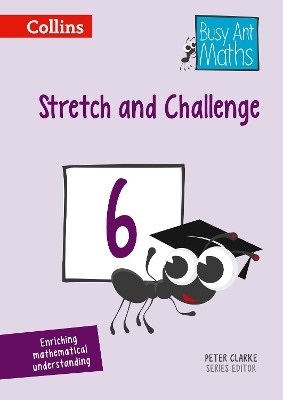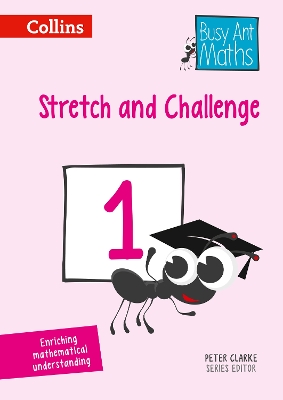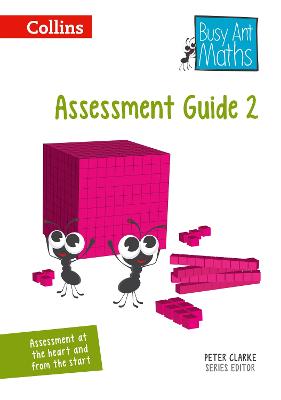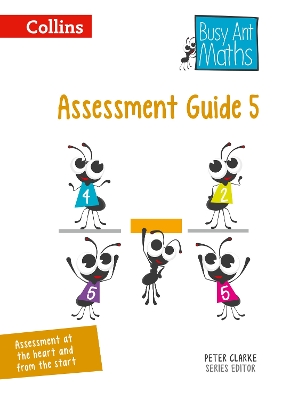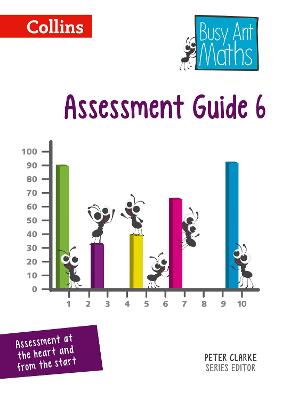Busy Ant Maths
19 total works
The Busy Ant Maths programme has assessment at the heart and from the start, embedding best practice across the school.
Using the assessment tool on Collins Connect together with this guide offers you a simple and robust way of assessing and capturing progress and communicating it effectively to pupils, other teachers and parents.
"The Busy Ant Maths programme has assessment at the heart and from the start, embedding best practice across the school.
Using the assessment tool on Collins Connect together with this guide offers you a simple and robust way of assessing and capturing progress and communicating it effectively to pupils, other teachers and parents.
Written by an expert author team with over 50 years' combined classroom experience, Busy Ant Maths is a flexible, whole-school mathematics programme that ensures conceptual understanding and mathematical fluency from the start. "
Pupils can quickly get to grips with KS2 problem solving and reasoning by completing activities categorised by topic and question type.
Fully in line with the new National Curriculum.
Problem solving and reasoning have been key focuses within primary maths since the introduction of the 2014 curriculum, and the focus on 'teaching for mastery'. It is essential that all pupils have access to problem solving and reasoning activities. Some key benefits to problem solving in maths include:
* Helping pupils grasp diverse mathematical concepts and understand the application of the subject
* Enhancing strategic thinking
* Developing transferable skills
This book consists of three different types of mathematical problem solving challenges:
1. Solving mathematical problems. This involves pupils solving problems 'within' mathematics itself, recognising patterns and relationships, making conjectures and generalisations, and explaining and justifying conclusions.
2. Reasoning mathematically. This involved pupils using logical thinking to solve problems, focusing on making conjectures and generalisations, and explaining and justifying conclusions using appropriate language.
3. Using & applying mathematics in real-world contexts. This involves pupils engaging in challenges that require them to use and apply their mathematical knowledge and skills in open-ended, real-world contexts.
Pupils can quickly get to grips with KS2 problem solving and reasoning by completing activities categorised by topic and question type.
Fully in line with the new National Curriculum.
Problem solving and reasoning have been key focuses within primary maths since the introduction of the 2014 curriculum, and the focus on 'teaching for mastery'. It is essential that all pupils have access to problem solving and reasoning activities. Some key benefits to problem solving in maths include:
* Helping pupils grasp diverse mathematical concepts and understand the application of the subject
* Enhancing strategic thinking
* Developing transferable skills
This book consists of three different types of mathematical problem solving challenges:
1. Solving mathematical problems. This involves pupils solving problems 'within' mathematics itself, recognising patterns and relationships, making conjectures and generalisations, and explaining and justifying conclusions.
2. Reasoning mathematically. This involved pupils using logical thinking to solve problems, focusing on making conjectures and generalisations, and explaining and justifying conclusions using appropriate language.
3. Using & applying mathematics in real-world contexts. This involves pupils engaging in challenges that require them to use and apply their mathematical knowledge and skills in open-ended, real-world contexts.
Pupils can quickly get to grips with KS1 problem solving and reasoning by completing activities categorised by topic and question type.
Fully in line with the new National Curriculum.
Problem solving and reasoning have been key focuses within primary maths since the introduction of the 2014 curriculum, and the focus on 'teaching for mastery'. It is essential that all pupils have access to problem solving and reasoning activities. Some key benefits to problem solving in maths include:
* Helping pupils grasp diverse mathematical concepts and understand the application of the subject
* Enhancing strategic thinking
* Developing transferable skills
This book consists of three different types of mathematical problem solving challenges:
1. Solving mathematical problems. This involves pupils solving problems 'within' mathematics itself, recognising patterns and relationships, making conjectures and generalisations, and explaining and justifying conclusions.
2. Reasoning mathematically. This involved pupils using logical thinking to solve problems, focusing on making conjectures and generalisations, and explaining and justifying conclusions using appropriate language.
3. Using & applying mathematics in real-world contexts. This involves pupils engaging in challenges that require them to use and apply their mathematical knowledge and skills in open-ended, real-world contexts.
Pupils can quickly get to grips with KS1 problem solving and reasoning by completing activities categorised by topic and question type.
Fully in line with the new National Curriculum.
Problem solving and reasoning have been key focuses within primary maths since the introduction of the 2014 curriculum, and the focus on 'teaching for mastery'. It is essential that all pupils have access to problem solving and reasoning activities. Some key benefits to problem solving in maths include:
* Helping pupils grasp diverse mathematical concepts and understand the application of the subject
* Enhancing strategic thinking
* Developing transferable skills
This book consists of three different types of mathematical problem solving challenges:
1. Solving mathematical problems. This involves pupils solving problems 'within' mathematics itself, recognising patterns and relationships, making conjectures and generalisations, and explaining and justifying conclusions.
2. Reasoning mathematically. This involved pupils using logical thinking to solve problems, focusing on making conjectures and generalisations, and explaining and justifying conclusions using appropriate language.
3. Using & applying mathematics in real-world contexts. This involves pupils engaging in challenges that require them to use and apply their mathematical knowledge and skills in open-ended, real-world contexts.
Pupils can quickly get to grips with KS2 problem solving and reasoning by completing activities categorised by topic and question type.
Fully in line with the new National Curriculum.
Problem solving and reasoning have been key focuses within primary maths since the introduction of the 2014 curriculum, and the focus on 'teaching for mastery'. It is essential that all pupils have access to problem solving and reasoning activities. Some key benefits to problem solving in maths include:
* Helping pupils grasp diverse mathematical concepts and understand the application of the subject
* Enhancing strategic thinking
* Developing transferable skills
This book consists of three different types of mathematical problem solving challenges:
1. Solving mathematical problems. This involves pupils solving problems 'within' mathematics itself, recognising patterns and relationships, making conjectures and generalisations, and explaining and justifying conclusions.
2. Reasoning mathematically. This involved pupils using logical thinking to solve problems, focusing on making conjectures and generalisations, and explaining and justifying conclusions using appropriate language.
3. Using & applying mathematics in real-world contexts. This involves pupils engaging in challenges that require them to use and apply their mathematical knowledge and skills in open-ended, real-world contexts.
Challenge and stretch Year 5 pupils with this resource designed to broaden and deepen children’s mathematical understanding. This book supports the classroom teacher in delivering structured guidance and support for gifted children who are exceeding age-related expectations in mathematics.
- contains 36 photocopiable newspaper-style issues packed with investigations, problem-solving activities and maths challenges
- specific teacher guidance (and answers) in the accompanying teachers notes for all 36 issues
- all content is within the years programme of study
- evaluate children’s learning and identify the next steps for progression with detailed assessment guidance
- encourage children to apply their mathematical knowledge and skills across the curriculum with cross-curricular activities
The Busy Ant Maths programme has assessment at the heart and from the start, embedding best practice across the school.
Using the assessment tool on Collins Connect together with this guide offers you a simple and robust way of assessing and capturing progress and communicating it effectively to pupils, other teachers and parents.
"The Busy Ant Maths programme has assessment at the heart and from the start, embedding best practice across the school.
Using the assessment tool on Collins Connect together with this guide offers you a simple and robust way of assessing and capturing progress and communicating it effectively to pupils, other teachers and parents.
Written by an expert author team with over 50 years' combined classroom experience, Busy Ant Maths is a flexible, whole-school mathematics programme that ensures conceptual understanding and mathematical fluency from the start. "
Pupils can quickly get to grips with KS2 problem solving and reasoning by completing activities categorised by topic and question type.
Fully in line with the new National Curriculum.
Problem solving and reasoning have been key focuses within primary maths since the introduction of the 2014 curriculum, and the focus on 'teaching for mastery'. It is essential that all pupils have access to problem solving and reasoning activities. Some key benefits to problem solving in maths include:
* Helping pupils grasp diverse mathematical concepts and understand the application of the subject
* Enhancing strategic thinking
* Developing transferable skills
This book consists of three different types of mathematical problem solving challenges:
1. Solving mathematical problems. This involves pupils solving problems 'within' mathematics itself, recognising patterns and relationships, making conjectures and generalisations, and explaining and justifying conclusions.
2. Reasoning mathematically. This involved pupils using logical thinking to solve problems, focusing on making conjectures and generalisations, and explaining and justifying conclusions using appropriate language.
3. Using & applying mathematics in real-world contexts. This involves pupils engaging in challenges that require them to use and apply their mathematical knowledge and skills in open-ended, real-world contexts.
The Busy Ant Maths programme has assessment at the heart and from the start, embedding best practice across the school.
This guide offers you a simple and robust way of assessing and capturing progress and communicating it effectively to pupils, other teachers and parents.
The Busy Ant Maths programme has assessment at the heart and from the start, embedding best practice across the school.
This guide offers you a simple and robust way of assessing and capturing progress and communicating it effectively to pupils, other teachers and parents.
Written by an expert author team with over 50 years’ combined classroom experience, Busy Ant Maths is a flexible, whole-school mathematics programme that ensures conceptual understanding and mathematical fluency from the start.
Ensure every pupil is fluent in the times tables up to and including 12x12 for success in the Multiplication Tables Check. This whole-school resource gives teachers new tools to help children memorise, recognise patterns, and secure mastery of the multiplication tables.
Make every minute count using the quick-fire tasks for lesson starters, times tables sessions or in small windows before or after break times.
- Master the multiplication tables with varied and purposeful practice.
- Develop rapid recall with whole-class, paired and individual games.
- Reduce workload with over 1000 pages of ready-to-use interactive PowerPoints, activity sheets, games boards, cards and more to download when you buy the book.
- Practice single or multiple tables at a time, with games suitable for use from Year 2 onwards.
Created by leading expert, Peter Clarke, Busy Ant Maths ensures confidence from the start for teachers and pupils, embedding best practice across the school. Peter Clarke has many years' experience in primary classroom teaching, leading curriculum development and writing best-selling maths resources.
Challenge and stretch Year 3 pupils with this resource designed to broaden and deepen children’s mathematical understanding. This book supports the classroom teacher in delivering structured guidance and support for gifted children who are exceeding age-related expectations in mathematics.
- contains 36 photocopiable newspaper-style issues packed with investigations, problem-solving activities and maths challenges
- specific teacher guidance (and answers) in the accompanying teachers notes for all 36 issues
- all content is within the years programme of study
- evaluate children’s learning and identify the next steps for progression with detailed assessment guidance
- encourage children to apply their mathematical knowledge and skills across the curriculum with cross-curricular activities
Challenge and stretch Year 4 pupils with this resource designed to broaden and deepen children’s mathematical understanding. This book supports the classroom teacher in delivering structured guidance and support for gifted children who are exceeding age-related expectations in mathematics.
- contains 36 photocopiable newspaper-style issues packed with investigations, problem-solving activities and maths challenges
- specific teacher guidance (and answers) in the accompanying teachers notes for all 36 issues
- all content is within the years programme of study
- evaluate children’s learning and identify the next steps for progression with detailed assessment guidance
- encourage children to apply their mathematical knowledge and skills across the curriculum with cross-curricular activities
Challenge and stretch Year 2 pupils with this resource designed to broaden and deepen children's mathematical understanding. This book supports the classroom teacher in delivering structured guidance and support for gifted children who are exceeding age-related expectations in mathematics.
- contains 36 photocopiable newspaper-style issues packed with investigations, problem-solving activities and maths challenges
- specific teacher guidance (and answers) in the accompanying teachers notes for all 36 issues
- all content is within the years programme of study
- evaluate children's learning and identify the next steps for progression with detailed assessment guidance
- encourage children to apply their mathematical knowledge and skills across the curriculum with cross-curricular activities
Challenge and stretch Year 6 pupils with this resource designed to broaden and deepen children’s mathematical understanding. This book supports the classroom teacher in delivering structured guidance and support for gifted children who are exceeding age-related expectations in mathematics.
- contains 36 photocopiable newspaper-style issues packed with investigations, problem-solving activities and maths challenges
- specific teacher guidance (and answers) in the accompanying teachers notes for all 36 issues
- all content is within the years programme of study
- evaluate children’s learning and identify the next steps for progression with detailed assessment guidance
- encourage children to apply their mathematical knowledge and skills across the curriculum with cross-curricular activities
Challenge and stretch Year 1 pupils with this resource designed to broaden and deepen children's mathematical understanding. This book supports the classroom teacher in delivering structured guidance and support for gifted children who are exceeding age-related expectations in mathematics.
- contains 36 photocopiable newspaper-style issues packed with investigations, problem-solving activities and maths challenges
- specific teacher guidance (and answers) in the accompanying teachers notes for all 36 issues
- all content is within the years programme of study
- evaluate children's learning and identify the next steps for progression with detailed assessment guidance
- encourage children to apply their mathematical knowledge and skills across the curriculum with cross-curricular activities
The Busy Ant Maths programme has assessment at the heart and from the start, embedding best practice across the school.
This guide offers you a simple and robust way of assessing and capturing progress and communicating it effectively to pupils, other teachers and parents.
The Busy Ant Maths programme has assessment at the heart and from the start, embedding best practice across the school.
This guide offers you a simple and robust way of assessing and capturing progress and communicating it effectively to pupils, other teachers and parents.
Written by an expert author team with over 50 years’ combined classroom experience, Busy Ant Maths is a flexible, whole-school mathematics programme that ensures conceptual understanding and mathematical fluency from the start.
The Busy Ant Maths programme has assessment at the heart and from the start, embedding best practice across the school.
This guide offers you a simple and robust way of assessing and capturing progress and communicating it effectively to pupils, other teachers and parents.
The Busy Ant Maths programme has assessment at the heart and from the start, embedding best practice across the school.
This guide offers you a simple and robust way of assessing and capturing progress and communicating it effectively to pupils, other teachers and parents.
Written by an expert author team with over 50 years’ combined classroom experience, Busy Ant Maths is a flexible, whole-school mathematics programme that ensures conceptual understanding and mathematical fluency from the start.
The Busy Ant Maths programme has assessment at the heart and from the start, embedding best practice across the school.
This guide offers you a simple and robust way of assessing and capturing progress and communicating it effectively to pupils, other teachers and parents.
The Busy Ant Maths programme has assessment at the heart and from the start, embedding best practice across the school.
This guide offers you a simple and robust way of assessing and capturing progress and communicating it effectively to pupils, other teachers and parents.
Written by an expert author team with over 50 years’ combined classroom experience, Busy Ant Maths is a flexible, whole-school mathematics programme that ensures conceptual understanding and mathematical fluency from the start.

